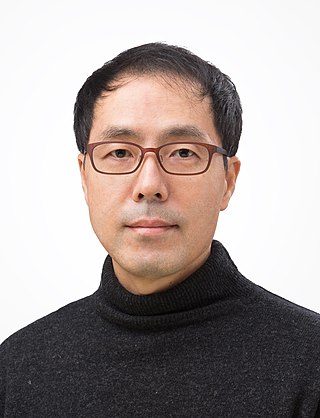
Nonlinear optics (NLO) is the branch of optics that describes the behaviour of light in nonlinear media, that is, media in which the polarization density P responds non-linearly to the electric field E of the light. The non-linearity is typically observed only at very high light intensities (when the electric field of the light is >108 V/m and thus comparable to the atomic electric field of ~1011 V/m) such as those provided by lasers. Above the Schwinger limit, the vacuum itself is expected to become nonlinear. In nonlinear optics, the superposition principle no longer holds.
A photon is an elementary particle that is a quantum of the electromagnetic field, including electromagnetic radiation such as light and radio waves, and the force carrier for the electromagnetic force. Photons are massless particles that always move at the speed of light measured in vacuum. The photon belongs to the class of boson particles.

Spectroscopy is the field of study that measures and interprets electromagnetic spectra. In narrower contexts, spectroscopy is the precise study of color as generalized from visible light to all bands of the electromagnetic spectrum.
Atomic, molecular, and optical physics (AMO) is the study of matter–matter and light–matter interactions, at the scale of one or a few atoms and energy scales around several electron volts. The three areas are closely interrelated. AMO theory includes classical, semi-classical and quantum treatments. Typically, the theory and applications of emission, absorption, scattering of electromagnetic radiation (light) from excited atoms and molecules, analysis of spectroscopy, generation of lasers and masers, and the optical properties of matter in general, fall into these categories.
In electromagnetism, Brillouin scattering, named after Léon Brillouin, refers to the interaction of light with the material waves in a medium. It is mediated by the refractive index dependence on the material properties of the medium; as described in optics, the index of refraction of a transparent material changes under deformation.

In physics, Raman scattering or the Raman effect is the inelastic scattering of photons by matter, meaning that there is both an exchange of energy and a change in the light's direction. Typically this effect involves vibrational energy being gained by a molecule as incident photons from a visible laser are shifted to lower energy. This is called normal Stokes-Raman scattering.

In physics, absorption of electromagnetic radiation is how matter takes up a photon's energy — and so transforms electromagnetic energy into internal energy of the absorber.
Coherent anti-Stokes Raman spectroscopy, also called Coherent anti-Stokes Raman scattering spectroscopy (CARS), is a form of spectroscopy used primarily in chemistry, physics and related fields. It is sensitive to the same vibrational signatures of molecules as seen in Raman spectroscopy, typically the nuclear vibrations of chemical bonds. Unlike Raman spectroscopy, CARS employs multiple photons to address the molecular vibrations, and produces a coherent signal. As a result, CARS is orders of magnitude stronger than spontaneous Raman emission. CARS is a third-order nonlinear optical process involving three laser beams: a pump beam of frequency ωp, a Stokes beam of frequency ωS and a probe beam at frequency ωpr. These beams interact with the sample and generate a coherent optical signal at the anti-Stokes frequency (ωpr+ωp-ωS). The latter is resonantly enhanced when the frequency difference between the pump and the Stokes beams (ωp-ωS) coincides with the frequency of a Raman resonance, which is the basis of the technique's intrinsic vibrational contrast mechanism.
Raman amplification is based on the stimulated Raman scattering (SRS) phenomenon, when a lower frequency 'signal' photon induces the inelastic scattering of a higher-frequency 'pump' photon in an optical medium in the nonlinear regime. As a result of this, another 'signal' photon is produced, with the surplus energy resonantly passed to the vibrational states of the medium. This process, as with other stimulated emission processes, allows all-optical amplification. Optical fiber is today most used as the nonlinear medium for SRS for telecom purposes; in this case it is characterized by a resonance frequency downshift of ~11 THz. The SRS amplification process can be readily cascaded, thus accessing essentially any wavelength in the fiber low-loss guiding windows. In addition to applications in nonlinear and ultrafast optics, Raman amplification is used in optical telecommunications, allowing all-band wavelength coverage and in-line distributed signal amplification.
In quantum mechanics, a quantum eraser experiment is an interferometer experiment that demonstrates several fundamental aspects of quantum mechanics, including quantum entanglement and complementarity. The quantum eraser experiment is a variation of Thomas Young's classic double-slit experiment. It establishes that when action is taken to determine which of 2 slits a photon has passed through, the photon cannot interfere with itself. When a stream of photons is marked in this way, then the interference fringes characteristic of the Young experiment will not be seen. The experiment also creates situations in which a photon that has been "marked" to reveal through which slit it has passed can later be "unmarked." A photon that has been "unmarked" will interfere with itself once again, restoring the fringes characteristic of Young's experiment.

In atomic physics, two-photon absorption (TPA or 2PA), also called two-photon excitation or non-linear absorption, is the simultaneous absorption of two photons of identical or different frequencies in order to excite an atom or a molecule from one state (usually the ground state), via a virtual energy level, to a higher energy, most commonly an excited electronic state. Absorption of two photons with different frequencies is called non-degenerate two-photon absorption. Since TPA depends on the simultaneous absorption of two photons, the probability of TPA is proportional to the photon dose (D), which is proportional to the square of the light intensity (D ∝ I2); thus it is a nonlinear optical process. The energy difference between the involved lower and upper states of the molecule is equal or smaller than the sum of the photon energies of the two photons absorbed. Two-photon absorption is a third-order process, with absorption cross section typically several orders of magnitude smaller than one-photon absorption cross section.
PVLAS aims to carry out a test of quantum electrodynamics and possibly detect dark matter at the Department of Physics and National Institute of Nuclear Physics in Ferrara, Italy. It searches for vacuum polarization causing nonlinear optical behavior in magnetic fields. Experiments began in 2001 at the INFN Laboratory in Legnaro and continue today with new equipment.

Robert William Boyd is an American physicist noted for his work in optical physics and especially in nonlinear optics. He is currently the Canada Excellence Research Chair Laureate in Quantum Nonlinear Optics based at the University of Ottawa, professor of physics cross-appointed to the school of electrical engineering and computer science at the University of Ottawa, and professor of optics and professor of physics at the University of Rochester.
A parametric process is an optical process in which light interacts with matter in such a way as to leave the quantum state of the material unchanged. As a direct consequence of this there can be no net transfer of energy, momentum, or angular momentum between the optical field and the physical system. In contrast a non-parametric process is a process in which any part of the quantum state of the system changes.
Quantum-optical spectroscopy is a quantum-optical generalization of laser spectroscopy where matter is excited and probed with a sequence of laser pulses.
Linear optical quantum computing or linear optics quantum computation (LOQC), also photonic quantum computing (PQC), is a paradigm of quantum computation, allowing (under certain conditions, described below) universal quantum computation. LOQC uses photons as information carriers, mainly uses linear optical elements, or optical instruments (including reciprocal mirrors and waveplates) to process quantum information, and uses photon detectors and quantum memories to detect and store quantum information.
Integrated quantum photonics, uses photonic integrated circuits to control photonic quantum states for applications in quantum technologies. As such, integrated quantum photonics provides a promising approach to the miniaturisation and scaling up of optical quantum circuits. The major application of integrated quantum photonics is Quantum technology:, for example quantum computing, quantum communication, quantum simulation, quantum walks and quantum metrology.

Cho Minhaeng is a South Korean scientist in researching physical chemistry, spectroscopy, and microscopy. He was director of the National Creative Research Initiative Center for Coherent Multidimensional Spectroscopy and is founding director of the Center for Molecular Spectroscopy and Dynamics in the Institute for Basic Science (IBS), located in Korea University.

Hyper–Rayleigh scattering optical activity, a form of chiroptical harmonic scattering, is a nonlinear optical physical effect whereby chiral scatterers convert light to higher frequencies via harmonic generation processes, in a way that the intensity of generated light depends on the chirality of the scatterers. "Hyper–Rayleigh scattering" is a nonlinear optical counterpart to Rayleigh scattering. "Optical activity" refers to any changes in light properties that are due to chirality.

Malvin Carl Teich is an American electrical engineer, physicist, and computational neuroscientist which is professor emeritus of electrical engineering at Columbia University and physics at Boston University. He is also a consultant to government, academia, and private industry, where he serves as an advisor in intellectual-property conflicts. He is the coauthor of Fundamentals of Photonics, and of Fractal-Based Point Processes.









